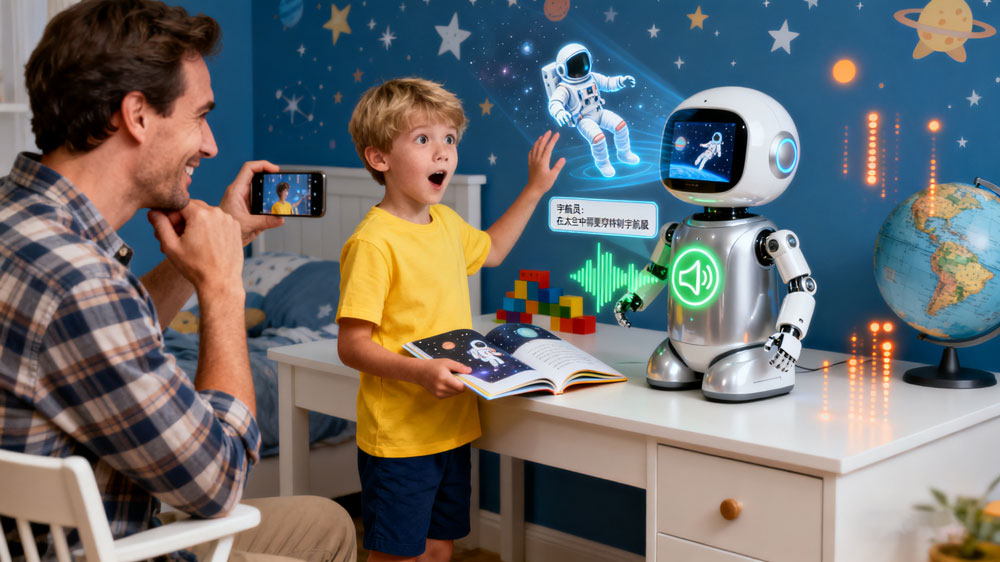The integration of multimodal AI—combining voice, vision, and emotional recognition—is redefining playtime from passive entertainment to dynamic, adaptive learning experiences.
In recent years, artificial intelligence has evolved from performing simple voice commands to enabling rich, contextual interactions in toys. With advancements in multimodal AI technology, modern toys can now see, listen, understand emotions, and respond in real time—creating deeply engaging and personalized experiences for children.

Leading brands are leveraging these capabilities to offer more than just entertainment; they are building smart companions that support emotional growth, creativity, and cognitive development.
How Multimodal AI is Reshaping Toy Experiences
Multimodal AI allows toys to process multiple forms of sensory input simultaneously. For instance, a toy can use its camera to identify a child’s drawing, analyze its colors and shapes through computer vision, and then generate a spoken story based on what it “sees.” This creates a fluid, interactive loop that mimics human-like engagement.
Key technological features driving this trend include:
- Visual Recognition
AI-powered cameras in toys can recognize objects, gestures, and even emotions, allowing responses that are context-aware. For example, an AI doll might suggest a calming game if it detects a child looking sad.
- Natural Language Understanding
Beyond pre-set commands, these toys engage in meaningful dialogues, answer curiosity-driven questions, and adapt their language to the child’s age.
- Emotion Sensing
Through tone analysis and facial expression recognition, toys can tailor interactions to a child’s mood, promoting emotional intelligence.
- Personalized Content Generation
Some AI toys create stories, puzzles, or songs based on the child’s preferences, making every interaction unique.
The Demand: Tech-Savvy Parents Seek Educational Value
Today’s parents, especially millennials and Gen Z, increasingly prioritize educational quality and emotional benefits in toys. They are drawn to products that offer:
- STEAM Skill Development
Toys that integrate coding, problem-solving, or scientific exploration align with parents’ desires to prepare children for a tech-driven future.
- Emotional Support
In a busy world, AI companions can offer patience and consistency, helping children articulate feelings and develop social skills.
- Ethical and Safe Design
Parents expect transparency in data privacy, child-safe materials, and content moderation. Brands that emphasize security gain a significant edge.
Success Stories: Brands Leading with AI Innovation
Companies like CogniToy, Miko, and Boxer have successfully merged AI with developmental play. For instance:
- Miko uses emotional intelligence algorithms to engage kids in conversations while adapting to their interaction style.
- Moxie, a social robot, combines storytelling with emotional lessons, supporting children’s mental well-being.
These brands don’t just sell toys—they offer parents a trusted partner in their child’s growth.
What Retailers Should Know
For retailers targeting educated, tech-oriented families, stocking AI-enabled toys requires a focus on:
- Demonstrating Real-World Impact
Use videos or in-store displays to show how the toy interacts—not just what it does.
- Clarifying Data Protection Measures
Highlight compliance with regulations like COPPA (Children’s Online Privacy Protection Act).
- Offering Tiered Price Points
From entry-level interactive puzzles to high-end companion robots, ensure a range for different budgets.
- Providing Parent-Friendly Guides
Simplify how the technology benefits learning or emotional growth.
The Future: Toward Hyper-Personalized Play
As AI models become more sophisticated, we will see toys that grow with the child, remember past interactions, and even connect with other smart devices to create immersive ecosystems. The key will be balancing innovation with humanity—ensuring technology enhances, rather than replaces, genuine connection.
For retailers and manufacturers, the message is clear: the future of toys isn’t just about smarter tech—it’s about building smarter relationships with young users and their families.
Post time: Sep-30-2025



